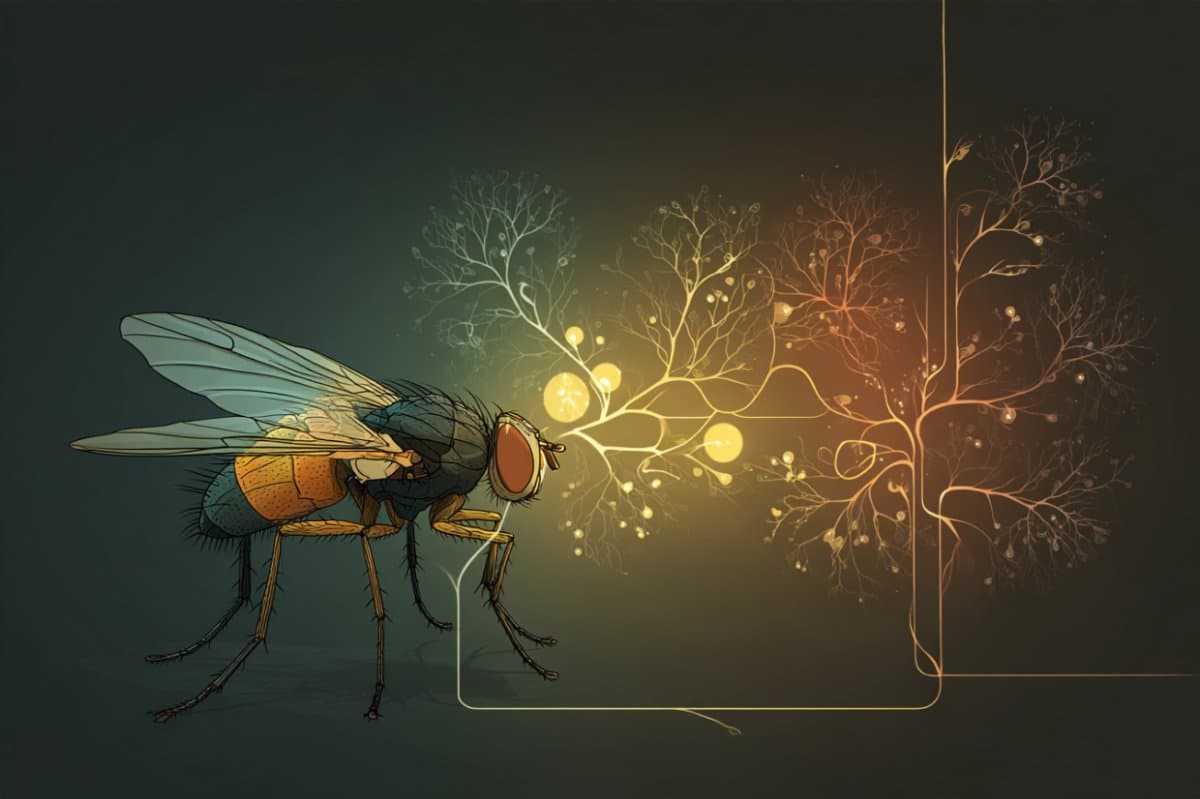Summary: New research shows a single neuron in fruit flies can trigger two distinct behaviors in response to the same smell. When detecting rotting fruit, one downstream pathway drives the flies toward the source, while another pathway controls their walking speed.
This multifunctional signaling challenges the long-held idea that each neuron serves just one purpose. The findings could help unravel how neural circuits encode complex behaviors efficiently.
Key facts:
- A single olfactory neuron can produce divergent signals that control direction and speed.
- Two downstream neurons respond differently to the same input: one maintains motion, the other adjusts pace.
- The study provides insight into how compact neural circuits perform multiple functions.
Source: Yale
The same neuron can tell fruit flies to walk towards the smell of rotting fruit and speed up, according to new research from Yale scientists.
Neurobiologists once believed that each neuron held a single purpose. However, in recent decades, research suggests that some neurons are multifunctional.

Now, a new study published recently in Current Biology suggests that an olfactory neuron in fruit flies was able to get two downstream neurons to act in different ways using the same message. These divergent electrical signals enabled fruit flies to respond in two distinct ways to the same smell.
The study adds fruit flies to a growing list of animals that have multifunctional neurons, joining crayfish, roundworms, mice, and humans.
“These divergent dynamics really kind of blew me away,” says James Jeanne, PhD, associate professor of neuroscience at Yale School of Medicine and senior author of the study.
“It seems like a feature that shows up basically anytime anybody looks for it, but its function has been unclear,” says Jeanne.
Mapping neurons in fruit fly brains
Animals respond to the world around them by collecting sensory information and translating it into action. This involves chains of neurons, typically starting with receptor neurons—such as cones or rods in the visual system—and ending with neurons that stimulate behavior, such as motor neurons.
Scientists are mapping out these chains, but that can be complicated in humans, who have billions of neurons. So scientists sometimes use model organisms with simpler nervous systems. Jeanne’s lab studies the olfactory, or smell, system in fruit flies, which have around 140,000 individual neurons in their brains.
Scientists have so far accurately mapped the functions of the first two layers of the fruit fly olfactory system. But what happens past these two layers remains unclear.
Hyong Kim, a graduate student in Jeanne’s lab, was studying this system when he saw that neurons in the third layer were responding to the same smell in “strikingly” different ways, says Jeanne.
“It pointed us to something changing from the second-order neurons to the third-order neurons,” he says.
One neuron triggers two behaviors
To test this, Jeanne and his colleagues decided to look at the electrical signals in neurons within the brain circuitry that processes food odors. Specifically, they measured electrical activity in response to ethyl acetate, a chemical signal of rotting fruit that is a major stimulus for the fruit fly brain.
When a fly detects this smell, a single type of receptor neuron in its antenna sends a message downstream to a single glomerular projection neuron (PN). This PN always sends the same electrical signal in response to this particular smell, passing it on to many different third-order neurons.
The researchers focused on two types of third-order neurons, which they called lateral horn neuron 1 (LHN1) and lateral horn neuron 2 (LHN2).
They looked at the behavior of LHN1 and LHN2 by measuring the electrical signal of these neurons while wafting the smell of ethyl acetate past the fruit fly. They found that LHN1 and LHN2 generated different electrical signals in response to the same smell. LHN1 maintained a steady electrical current the whole time the smell was present. LHN2, on the other hand, experienced a brief spike and then crashed.
Jeanne and his colleagues wanted to see whether these differences had an impact on behavior. So, they genetically modified fruit flies so that either their LHN1 or LHN2 didn’t function. Working with Thierry Emonet, PhD, Lewis B. Cullman Professor of Molecular, Cellular, and Developmental Biology, the researchers then placed modified fruit flies in a wind tunnel that simulated the smell of rotting fruit.
Typically, fruit flies walk towards the smell of rotting fruit. The more intense the smell, the faster they go. However, fruit flies that had their LHN2 disabled didn’t pick up the pace when the smell got more intense, suggesting that this brain pathway is responsible for a fruit fly speeding up when they get closer to their target.
Fruit flies with a disabled LHN1 still moved towards the source of the smell. But unlike untampered flies, they stopped moving when the concentration of the odor dipped.
Together, the findings suggest that even when the PN is receiving the same information—that rotting fruit is nearby—it can still pass on two different sets of directions down the neural pathway.
Why would that happen? It might have to do with efficiency, says Jeanne. “You can basically collapse all this information into a single neuron.”
Jeanne is now interested in whether there are any signatures, visible with electron microscopy, that predict these different types of neural transmission patterns. A connectivity map of every neuron in the fly brain was recently completed, but it only shows the structure of neural pathways.
“If the fine-scale details of individual connections between neurons predict their dynamics,” says Jeanne, “we could write the first entries onto a long-sought-after ‘Rosetta Stone’ for translating between circuit structure and circuit function.”
Funding: The research reported in this news article was supported by the National Institutes of Health (awards R01DC018570, R01NS116584, and RF1NS132840) and Yale University. The content is solely the responsibility of the authors and does not necessarily represent the official views of the National Institute of Health or other foundations.
Additional funding came from the Smith Family Foundation, the Klingenstein-Simons Fellowship Award in Neuroscience, and the Kavli Institute for Neuroscience at Yale University.
About this olfaction and neuroscience research news
Author: Freda Kreier
Source: Yale
Contact: Freda Kreier – Yale
Image: The image is credited to Neuroscience News
Original Research: Open access.
“Divergent synaptic dynamics originate parallel pathways for computation and behavior in an olfactory circuit” by James Jeanne et al. Current Biology
Abstract
Divergent synaptic dynamics originate parallel pathways for computation and behavior in an olfactory circuit
To enable diverse sensory processing and behavior, central circuits use divergent connectivity to create parallel pathways.
However, linking synaptic and cellular mechanisms to the circuit-level segregation of computation has been challenging.
Here, we investigate the generation of parallel processing pathways in the Drosophila olfactory system, where glomerular projection neurons (PNs) diverge onto many lateral horn neurons (LHNs).
We compare the effects of a single PN’s activity on two of its target LHNs. One LHN type generates sustained responses to odor and adapts divisively. The other generates transient responses and adapts subtractively.
The distinct odor-coding dynamics originate from differences in the dynamics of PN synapses targeting each LHN type. Sustained LHN responses arise from synapses that recover from depression quickly enough to maintain ongoing transmission.
Divisive adaptation is due to slow cellular gain control implemented by the Na+/K+ ATPase in the postsynaptic neuron.
Transient LHN responses arise from synapses that recover from depression too slowly to maintain ongoing transmission but that also facilitate when PN spike rate increases.
Interfering with facilitation via the calcium buffer EGTA or interfering with the presynaptic priming factor Unc13B diminishes the magnitude of initial transient responses.
Subtractive adaptation is due to the nonlinearity imposed by the spike threshold in the postsynaptic neuron.
Transient LHNs make corresponding transient contributions to behavioral odor attraction in walking flies, whereas sustained LHNs may make sustained, but nuanced, contributions.
Subcellular presynaptic specialization is thus a compact and efficient way to originate parallel information streams for specialized computation and behavior.






